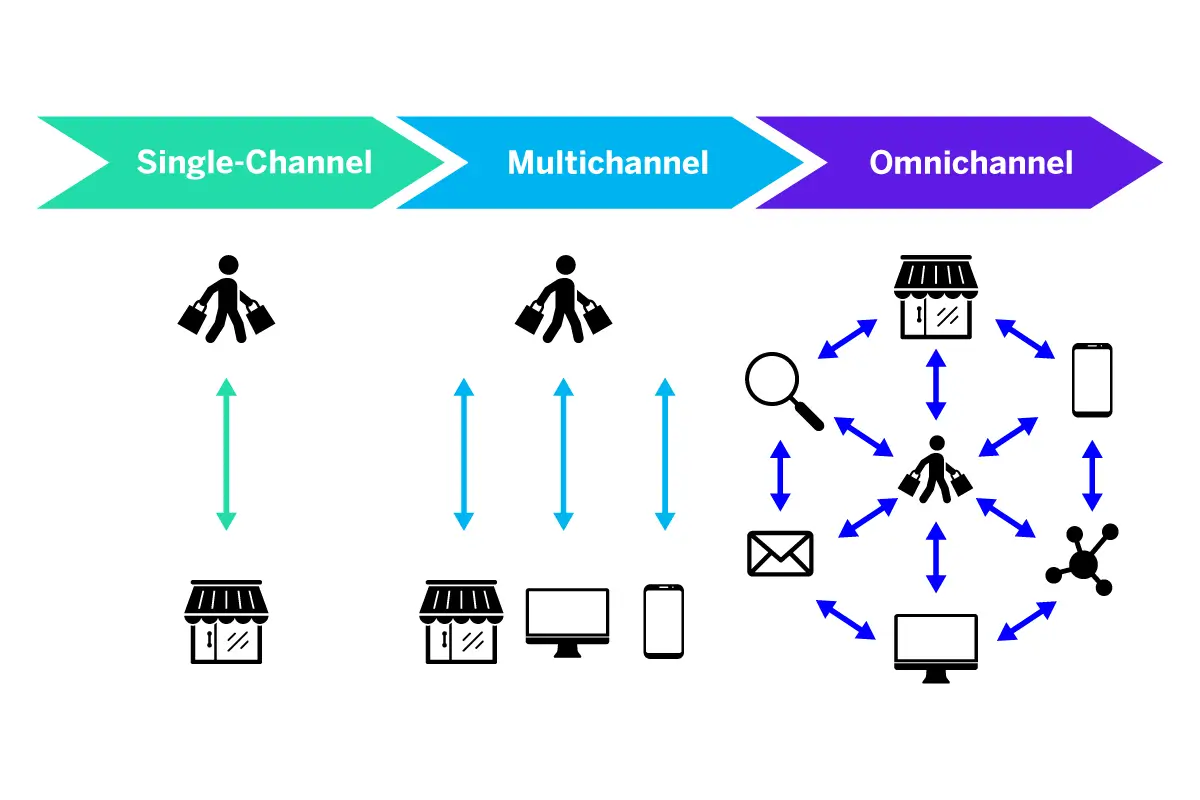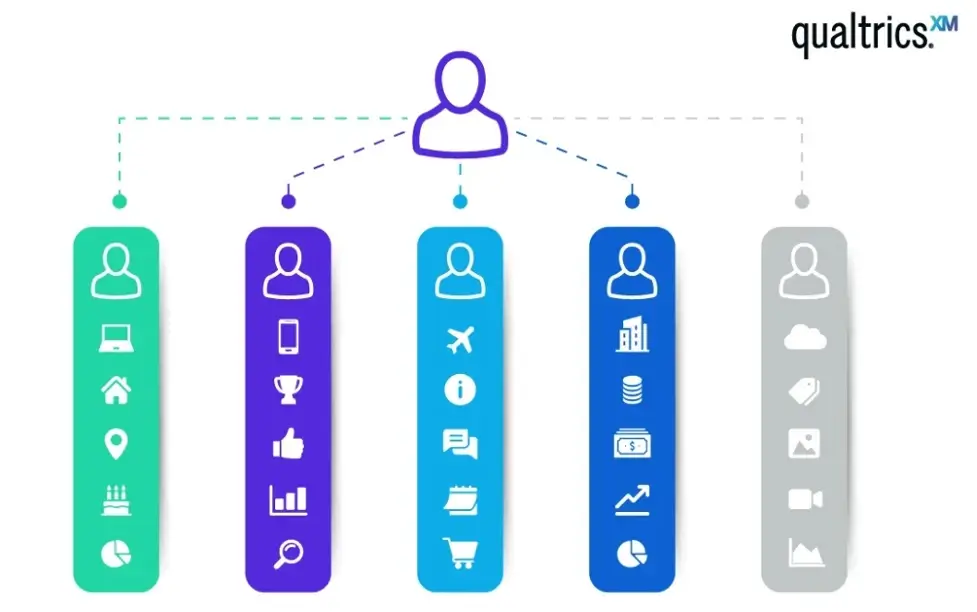Omnichannel definition
Omnichannel is the term given to an approach to communications, customer experience, and branding that unifies every available touchpoint and platform under one cohesive strategy.
‘Omni’ is a Latin prefix meaning ‘all’, so when we’re talking about omnichannel, we literally mean every single digital space that customers use and have access to.
That means treating emails, social media platforms, texts, phone calls, instant messaging, websites, physical stores, and everything in-between as equal parts of your presence – and linking them together in seamless ways. That even includes third-party websites like Google Reviews, Reddit, and Quora.
Omnichannel thinking helps drive customer satisfaction because it removes roadblocks and redundancies from otherwise fragmented customer journeys.
Free guide: Reimagining omnichannel CX in the age of AI
Omnichannel vs. multichannel vs. single-channel experience
The terms ‘omnichannel’ and ‘multichannel’ are sometimes used interchangeably, but they’re slightly different things. Single-channel, meanwhile, describes offerings that can only be bought or discussed via one touchpoint.
- A single-channel experience exists on only one destination. So that might be a boutique store with no online presence.
- A multichannel experience works across more than one single channel; for example, phone, and email.
- An omnichannel experience offers a seamless experience on every possible channel, so there’s never a ‘gap’ perceptible from the customer’s point of view.

A multi-channel experience is like dealing with a team of people who, although they all work at the same place, may or may not know the details of each other’s tasks, and have different styles and personalities. Omnichannel experience is like dealing with one person who is great at their job and can take care of all your needs while you sit back and relax.
What are the benefits of omnichannel?
Omnichannel bridges digital and physical divides to give your brand a cohesive, all-encompassing presence. When applied to the customer experience, an omnichannel strategy brings things together, supporting flexible journeys that jump between multiple channels.
The benefits here are numerous – primarily because you’ll be meeting people where and how they expect to find you.
Customer interactions are increasingly omnichannel by nature. As consumers, we like to move from social media channels to websites, to live chat issue resolution, and more – and to do so in whatever order we like. Omnichannel customer journeys make that kind of channel hopping feel seamless.
More than half of consumers now use three to five channels during a single purchase journey, while 70% of customers prefer brands that have multiple channels covered.
The good news is that omnichannel customer service and experiences are win-win investments. Get it right and you’ll not only drive customer loyalty, but you’ll make a positive impact on your bottom line.
McKinsey & Company, for example, found that “companies that implement omnichannel transformations report revenue growth of 5 to 15 percent and improvements in cost-to-serve efficiencies of 3 to 7 percent.”
That’s while Forrester research shows that 25% of omnichannel-capable brands “enjoyed revenue boosts and cost reductions alike, and 35% sold more premium items and 28% saw higher order values.”
Getting started with an omnichannel strategy
Any successful omnichannel strategy requires some thorough planning and careful consideration of your end goals – alongside a strong grasp on how you can measure the success of your efforts. Here’s a brief outline for how to bake omnichannel thinking into your business.
Set clear goals
Providing true omnichannel customer experience is a huge undertaking, and it’s never a solved problem. So it’s wise to begin with goals that you can work towards. These aims can be to improve metrics and KPIs, like boosting customer retention or customer satisfaction (CSAT scores), or more pragmatic – like offering a specific level of service on all of the channels you operate on.
These goals can help you build out a set of Objectives and Key Results (OKRs), which should in turn help you prioritize your efforts.
Get to know your customers and journeys
If you want to deliver on your omnichannel goals, you’ll need to know where your customers are, and what they expect. Customer data plays a huge role here, as the right analytics can reveal your different kinds of customer journey as people move between multiple channels. Use this information to make customer journey maps, and then think about how tightening your omnichannel screws can help facilitate smoother channel hopping.

Customer retention is on the line if you lose people as they move from touchpoint to touchpoint, so it pays to know where your experiences are lacking.
Audit and integrate your channels
Managing multiple channels is time-consuming, but you needn’t move from 0-100 overnight. Your customer data and journey mapping will hopefully show you which channels are highest priorities for your customers, and you can use that to hone in on a few that need urgent care and attention.
This isn’t about launching a TikTok account just so you can check the ‘be everywhere’ box; it’s about managing resources so that the channels you can serve customers on are unified in terms of customer support and overall quality of experience – and that you can help customers move between them without losing any relevant information.
Design a consistent, personalized experience
Whether it’s your omnichannel marketing strategy, the digital customer experience, or the processes followed by your customer service agents, it’s important that you use tools that can help you unify the experience while also adding in a layer of personalization for each customer.
That could mean being able to turn a post on X.com into a support call without making the customer repeat themselves, or it could be an email campaign that makes use of customer data to surface hyper relevant offers. What’s important is that you can make each customer feel understood as they move from touchpoint to touchpoint.
This all comes down to unified customer data that can link – and then surface – a customer’s ID and history in helpful situations, like on a customer service team’s dashboard, or generating personalized discounts when they visit your site.
Measure, refine, and test
Let’s say you want your omnichannel strategy to help boost customer satisfaction (CSAT) scores. You’ll first need to measure where they’re at using feedback surveys. Once you have a benchmark, you have something to compare things to once you’ve started to build a more consistent, unified omnichannel experience.
The game here is one of continual improvement, where you’ll see where things stand, take measures to improve, and then see if those measures have worked. This ‘test and learn’ process will help you figure out what customers expect, since positive impact on your KPIs will imply strides in the right direction.
Use the right tools
Unified customer data is hugely important to every single step here. Without a software platform that can analyze interactions, understand sentiment, build customer profiles and unite disparate datasets, all you can do is guess customer expectations and haphazardly try to spot-fix pain points.
True omnichannel customer experience requires tools that can monitor customer behavior, link information from different touchpoints, and surface actionable insights.

The Qualtrics® Experience Management Platform® does exactly this, leveraging millions of customer data points – and sorting the signal from the noise – to help brands build truly cohesive customer experiences that transcend platforms, channels and physical locations.
Examples of effective omnichannel strategies
Let’s take a look at a couple of brands that have nailed the omnichannel customer experience.
New Balance
Footwear giant New Balance has worked with Qualtrics to turn its siloed CX data points into a unified nerve center for customer insight. With a goal of bringing customer experience data into a single source of truth – and getting a real view on the voice of the customer – New Balance used the Qualtrics XM Platform® to deploy tailored CSAT and NPS surveying, before using our Discover model to bring unstructured data from other sources into the mix.
That meant the brand could proactively close the loop on customer feedback with a much more omnichannel approach, covering all the bases with feedback that influences every touchpoint.
Service Now
Sometimes omnichannel success means not letting a customer issue slip through the cracks. Digital business services provider ServiceNow, for example, wanted to deliver a world-class customer and partner experience across every channel and every customer journey – but that required a total revamp of their omnichannel CX practices.
With the help of the Qualtrics XM Platform®, ServiceNow has bridged divides in its channel ecosystem, and can now automatically route customer and partner feedback from any channel to the appropriate teams across the business.
These ‘closed-loop’ actions have big omnichannel implications. The CX Strategy team has determined that NPS for customers where they followed up on feedback is 12 points higher on average YoY than those with no follow-up.
What is omnichannel: FAQ
What are customers looking for with omnichannel?
Customers want a seamless, consistent experience no matter how they choose to interact with your brand – whether that’s online, in-store, via social media, or through customer service. They expect convenience, speed, and relevance, with the ability to pick up where they left off across channels.
Ultimately, people are looking for interactions that feel connected, personal, and effortless.
What channels should you consider with omnichannel?
An effective omnichannel approach considers both digital and physical touchpoints, tailored to where your customers are most active. This can include your website, mobile app, social media platforms, email, SMS, live chat, physical locations, contact centers, and even third-party marketplaces.
The right mix depends on your audience, but the goal is to ensure these channels work together to create a unified experience.
Where does omnichannel personalization come in?
Personalization underpins a great omnichannel experience. By leveraging customer data from across channels, you can tailor messages, product recommendations, and offers to individual needs and behaviors.
In that sense, personalized customer experience turns a scattershot digital presence into a cohesive journey. It’s what makes customers feel valued, understood, more likely to keep coming back.



